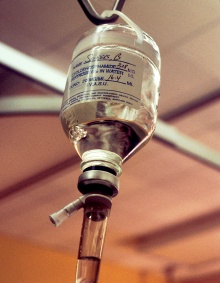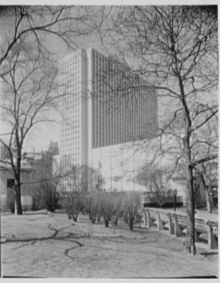A Reflection on Changes in Nursing: The First-Hand Observations and Experiences of a UB SON Alumna
Paula Glass, a graduate of UB School of Nursing's baccalaureate program, looks back on becoming a nurse in 1981 and discusses how times have changed -- from technology to practice to education.

Intravenous solutions were dispensed from glass bottles before the flexible bags seen today.
Attire
In 1981, nurses wore white scrub dresses, polished white shoes and white hose because no pants were allowed. We used toothpaste to make sure our white caps were “white.” We removed many layers – pants, boots and coats – that shielded us from the frigid snow and wind at 6:30 a.m. in Buffalo, New York, ready for clinical to start.
In June 1981, at the UB School of Nursing graduation, we threw our white caps towards the ceiling, and I never found mine again! We were told they were no longer needed for the standard RN uniform. Thirty-eight years later students, RNs and others wear brightly colored scrubs and shoes. Our attire has come a long way.
Technology
Technology was nonexistent and if a peer-reviewed article was assigned for reading, it was printed and placed on hold at the library where we physically went to read it. There was no electronic mail, learning management systems or electronic databases (e.g. CINAHL). Everything was done manually, using hard copy/paper. Today, we have internet and search engines to search for evidence-based guidelines, barcode scanning for safer medication administration, and Pyxis automatic counting to make our jobs easier and patient-care safer. Technology has helped us come a long way.
Licensing Exams

Glass sat for her licensing exam at the New York Coliseum.
I took the licensing boards within six months of graduation. In 1981, boards were five parts taken over two days. My test site was the NYC Coliseum where we were loaded by the thousands to fill each floor, which had been furnished with hundreds of wooden desks in rows. We were finger-printed prior to each part, as even then, confirming identify was a concern. It took several weeks to receive test results via the U.S. mail. Fortunately, the five-part system allowed one to keep his or her GN position and retake any unsuccessful part(s), and not the entire test. The process was tedious and we have come a long way with computerized testing and almost instant NCLEX-RN results.
Practice
My first RN position was at Memorial Sloan-Kettering Cancer Center in NYC. This was an honor and a challenge I gladly accepted after my UB SON capstone at Roswell Park Cancer Center. Nursing practices have changed since 1981, as I tell my students, primarily because there wasn’t any plastic. For example, intravenous (IV) catheters were metal butterflies and intravenous solutions were in glass bottles that often toppled over when patients ambulated. We saw IV pumps in the Special Care Unit only and fought gravity, a lot! We folded the edges of a piece of 2-inch silk tape to apply and hold the needle in the tubing (“piggybacked”) and be able to pry it apart again. Today, we use needleless systems and patient equipment is plastic disposable. We were told patients had Karposi’s sarcoma and we did not know they had AIDS, yet. Our unit (M-11) was a first to pilot 12-hour shifts in 1982. In Florida, 12-hour shifts were implemented 10 years later, in the 1990s, as I was here in South Florida for that change as well!
In 1981, and for much of the 20th century, medical record documentation was handwritten, and we used three colors of ink to identify shifts: days were written in blue/black, evenings in green and nights in red. Today, everything is electronic, typed into the EHR using passcodes and workstations on wheels.
In practice, we have come a long way. I wish I had saved my Luckmann and Sorenson Medical-Surgical Nursing (1974) textbook as I know knowledge we possess now, such as the complement system, was undiscovered yet.
Education
Nursing education has changed as students of three generations have smart phones, text, email, LMSs, internet, library access, publisher web-based support, eBooks, apps and more. I completed my MSN in Nursing (2004) and practiced as an Adult Nurse Practitioner for many years before becoming a nursing faculty. This prompted completion of a PhD in Nursing (2013). The UB SON instilled a strong commitment to nursing philosophies that include lifelong learning, scholarship, teaching and service.
I believe I have come a long way since that June day in 1981.
-Paula E. Glass, PhD, MSN, APRN, NP-C, CNE(c)